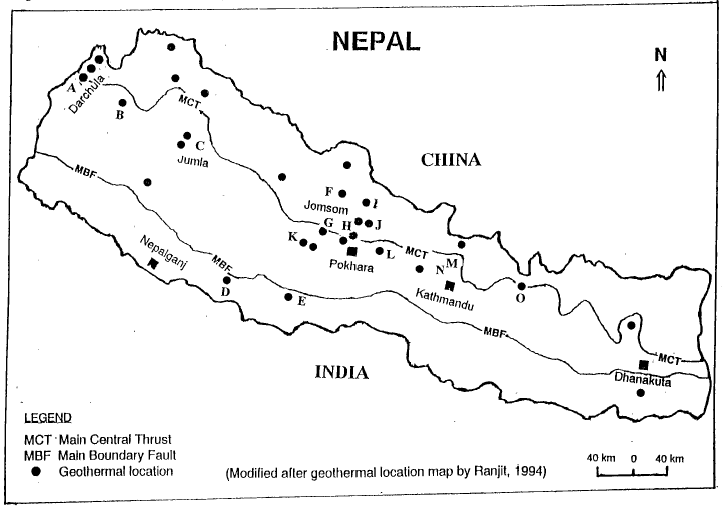|

Library >>
Renewable Energy Resource
Maps >> Asia
>> Geothermal >>
Nepal
Geothermal Energy Potential in Nepal
Location of thermal springs in
Nepal

Geothermal manifestations occur in
more than twenty-eight localities in Nepal, scattered
for the most part along the Main Central Thrust
and the Main Boundary Fault. Based on preliminary
scientific studies conducted in the early 80s over
a dozen geothermal localities, attempts to utilize
geothermal energy were abandoned since the subsurface
temperatures were not economically viable for generating
electricity.
The subsurface temperatures later
measured with other geothermometers were also found
to vary between 50° and 120°C. The surface temperature
of thermal water in different places ranges between
23° and 73°C. localities in Nepal, stretching right
across a southeast-northwest elongated region. Most
of these are confined to three distinct tectonic
and structural features that characterize the Himalayas
in general.
The first group is located beyond the Higher Himalayas
and north of the main Central Thrust (MCT), which
itself is situated between the units of the Lower
and Higher Himalayas. It dips northwards and separates
into two very different assemblages of rock. Below
it are gneiss, schist, phyllite, quartzite, and
marble of the Lesser Himalayan Formations. Above
it, a sequence of high-grade metamorphic.
http://www.geothermie.de/egec_geothernet/menu/frameset.htm
>> Geothermal Energy Update of Nepal
Countries
Afghanistan |
Armenia | Azerbaijan
| Bangladesh | Bhutan | Brunei | Cambodia | China
| Georgia | India |
Indonesia | Japan
| Kazakhstan | Korea, North | Korea, South | Kyrgyzstan
| Laos | Malaysia | Maldives | Mongolia
| Myanmar (Burma) | Nepal | Pakistan | Philippines
| Singapore | Sri Lanka | Tajikistan | Thailand
| Turkmenistan | Uzbekistan | Vietnam
|
Related GENI Resources
Links
|
Email
this page to a friend
Updated: 2016/06/30
If you speak another language fluently and you liked this page, make
a contribution by translating
it! For additional translations check out FreeTranslation.com
(Voor vertaling van Engels tot Nederlands)
(For oversettelse fra Engelsk til Norsk)
(Для дополнительных
переводов проверяют
FreeTranslation.com )



